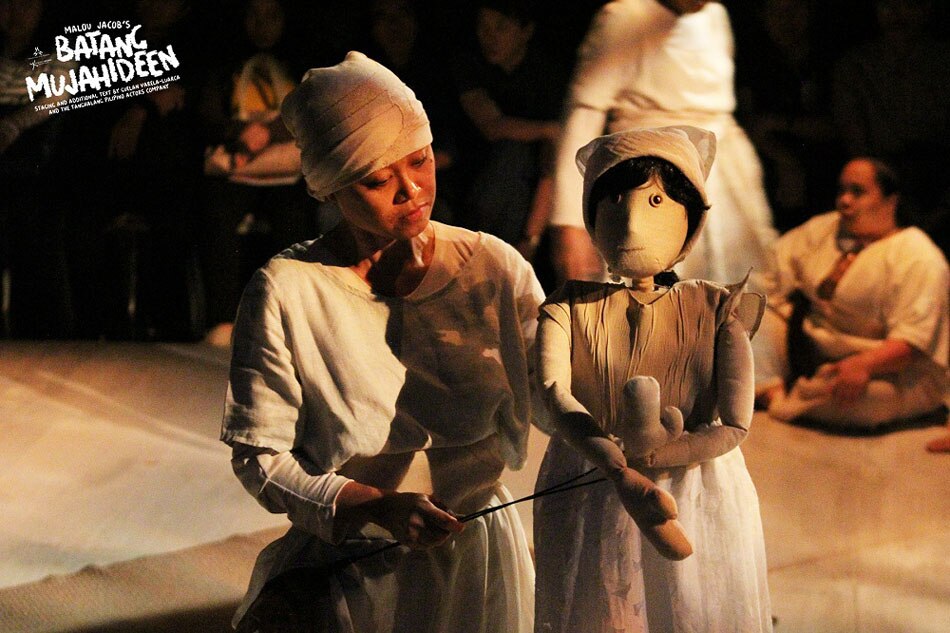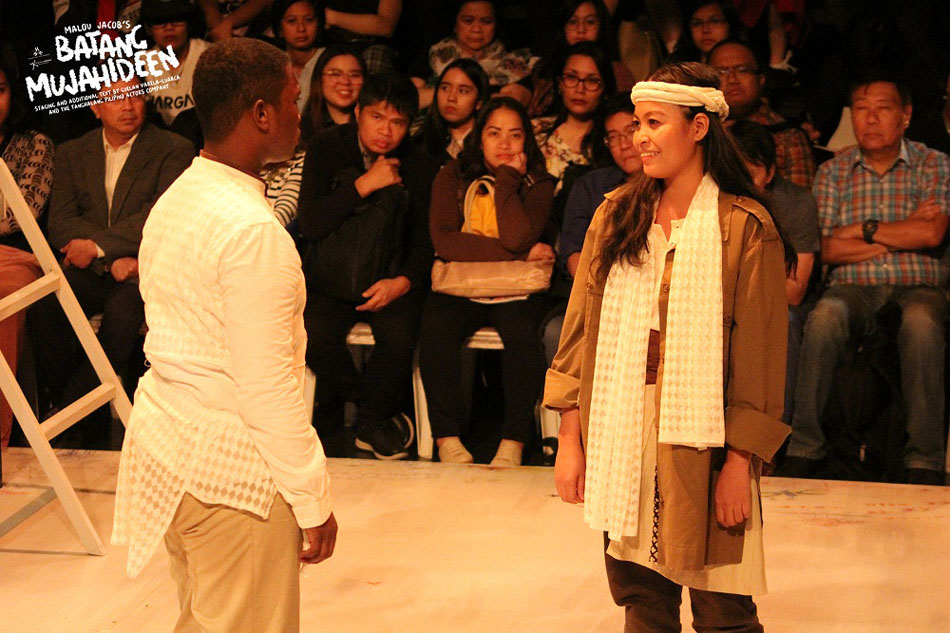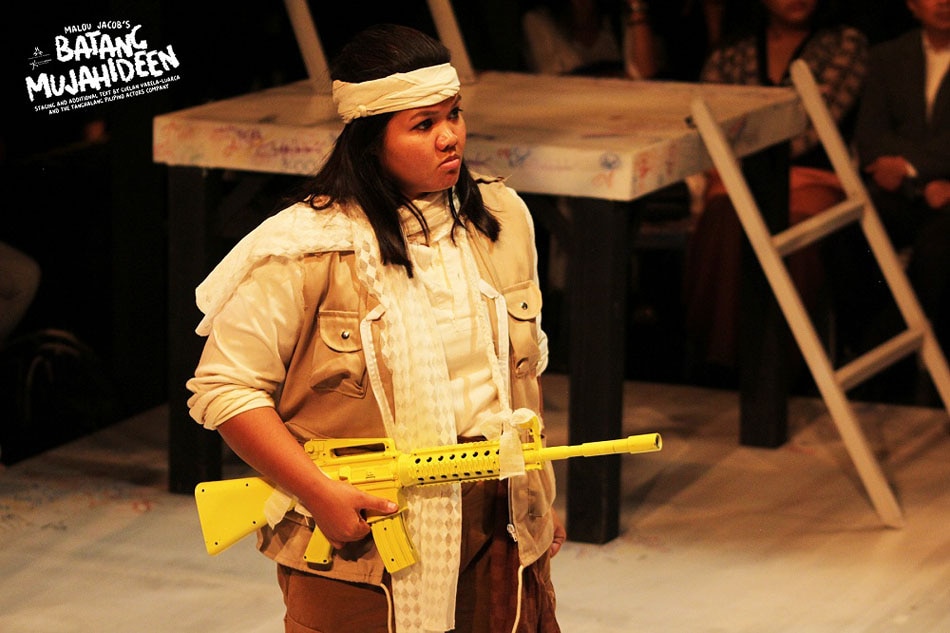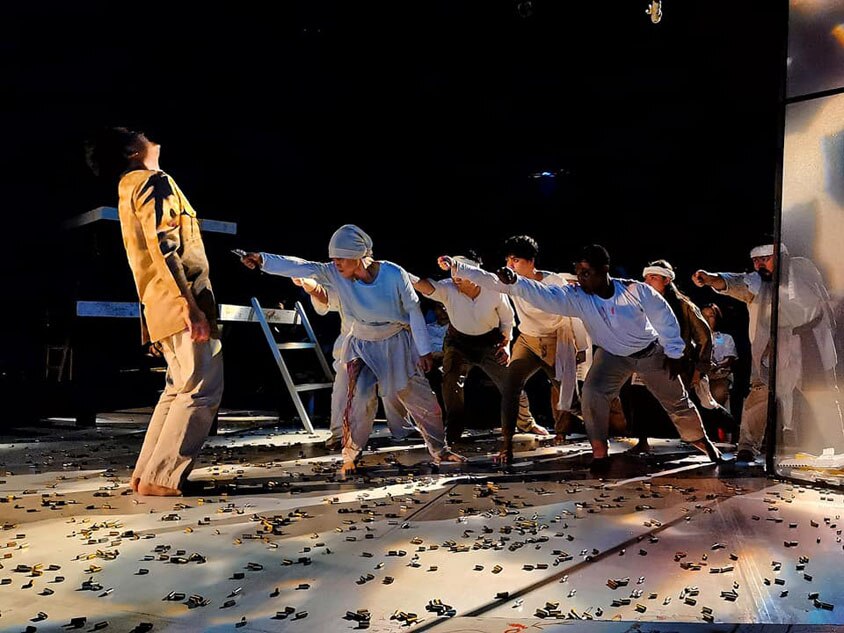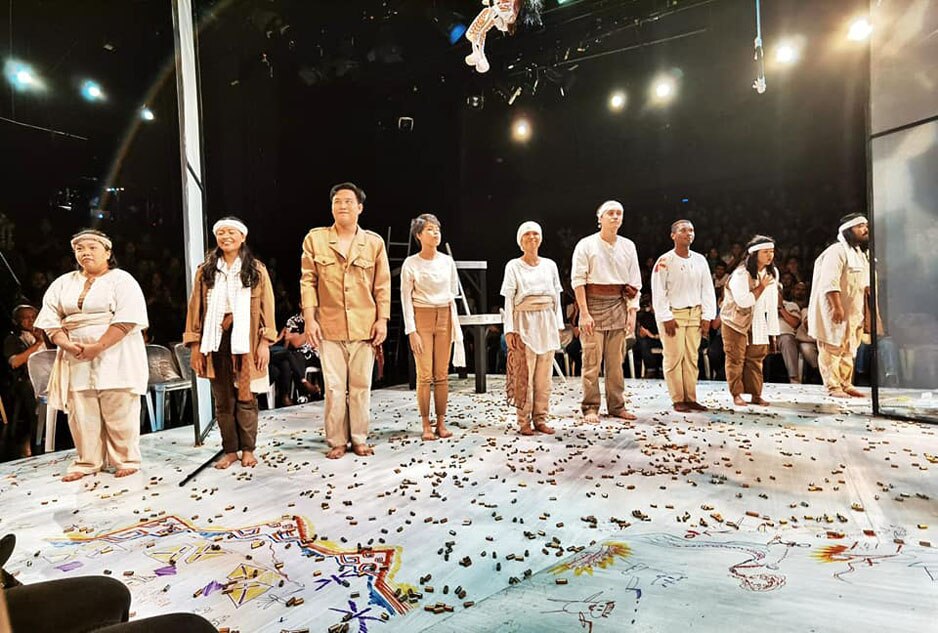Theater review: TP tackles Christian-Muslim relations in must-watch 'Batang Mujahideen'
ADVERTISEMENT

Welcome, Kapamilya! We use cookies to improve your browsing experience. Continuing to use this site means you agree to our use of cookies. Tell me more!
Theater review: TP tackles Christian-Muslim relations in must-watch 'Batang Mujahideen'
Fred Hawson
Published Mar 06, 2020 07:14 AM PHT
In March 2000, Abu Sayyaf rebels led by Ustadz Janjalani and Abu Sabaya held hostage all the Christian staff and students of Claret School in Tumahubong village in Basilan province. It was a grueling 45-day ordeal for all the hostages, particularly for the school priest Fr. Rhoel Gallardo (as the very symbol of the invaders' rival religion) and one of the teachers Ms. Marissa (with whom Ustadz took fancy on).
In March 2000, Abu Sayyaf rebels led by Ustadz Janjalani and Abu Sabaya held hostage all the Christian staff and students of Claret School in Tumahubong village in Basilan province. It was a grueling 45-day ordeal for all the hostages, particularly for the school priest Fr. Rhoel Gallardo (as the very symbol of the invaders' rival religion) and one of the teachers Ms. Marissa (with whom Ustadz took fancy on).
Meanwhile, 7-year old Yakan girl Fatima had just witnessed her father ruthlessly murdered and cannibalized by the blood-thirsty Christian extremist called Kumander. Soon after this heinous crime, Fatima was recruited by Abu Sabaya to become a "mujahideen" or a guerrilla fighter in the name of Islam. Ustadz hid Fatima under the boy's name Al Mustafa (meaning "chosen one") to undergo training, where she even bested the other boys in combat skills.
Meanwhile, 7-year old Yakan girl Fatima had just witnessed her father ruthlessly murdered and cannibalized by the blood-thirsty Christian extremist called Kumander. Soon after this heinous crime, Fatima was recruited by Abu Sabaya to become a "mujahideen" or a guerrilla fighter in the name of Islam. Ustadz hid Fatima under the boy's name Al Mustafa (meaning "chosen one") to undergo training, where she even bested the other boys in combat skills.
For "Batang Mujahideen," the Little Theater of the Cultural Center of the Philippines had been rearranged so that the audience members are seated on four sides of a slightly elevated square stage in the center. The show began with all nine members of the cast forming one diagonal line across the square and perform a washing ritual.
For "Batang Mujahideen," the Little Theater of the Cultural Center of the Philippines had been rearranged so that the audience members are seated on four sides of a slightly elevated square stage in the center. The show began with all nine members of the cast forming one diagonal line across the square and perform a washing ritual.
Doray Dayao stood up from the center of the line, broke the fourth wall to address the audience about what the play was going to be about, explaining how the character of Fatima was going to be represented by a puppet which she carried on her left arm and moved with sticks held by her right hand.
Doray Dayao stood up from the center of the line, broke the fourth wall to address the audience about what the play was going to be about, explaining how the character of Fatima was going to be represented by a puppet which she carried on her left arm and moved with sticks held by her right hand.
ADVERTISEMENT
Lhorie Nuevo was Ustadz and Eunice Pacia was Abu Sabaya, both compelling performances. Jonathan Tadioan played Fatima's proud father. Ybes Bagadiong was the ill-fated Fr. Gallardo. JV Ibesate played a chilling Kumander. Iman Ampatuan was Pyong, a Grade 4 student hostage at Claret. Monique Nellas had two memorably standout roles, as Fatima's grieving mother and as the unfortunate Ms. Marissa. Usual TP leading man Marco Viana oddly did not have a particular character to play.
Lhorie Nuevo was Ustadz and Eunice Pacia was Abu Sabaya, both compelling performances. Jonathan Tadioan played Fatima's proud father. Ybes Bagadiong was the ill-fated Fr. Gallardo. JV Ibesate played a chilling Kumander. Iman Ampatuan was Pyong, a Grade 4 student hostage at Claret. Monique Nellas had two memorably standout roles, as Fatima's grieving mother and as the unfortunate Ms. Marissa. Usual TP leading man Marco Viana oddly did not have a particular character to play.
It may not be easy to get into the drift of the story right away because the casting of the multiple characters of either religion fluidly changed among the actors, regardless of gender. Notably, the two Abu Sayyaf leaders were both played by women.
It may not be easy to get into the drift of the story right away because the casting of the multiple characters of either religion fluidly changed among the actors, regardless of gender. Notably, the two Abu Sayyaf leaders were both played by women.
There were also two stories being told in parallel, that of Fatima (fiction) and that of the Claret School hostage taking (factual), which can get confusing at first. However, eventually you will soon get the drift of the various experimental techniques (puppetry, documentary theater, devised theater) employed by adventurous young director Guelan Luarca in this staging, and be engrossed with the drama up to the very end.
There were also two stories being told in parallel, that of Fatima (fiction) and that of the Claret School hostage taking (factual), which can get confusing at first. However, eventually you will soon get the drift of the various experimental techniques (puppetry, documentary theater, devised theater) employed by adventurous young director Guelan Luarca in this staging, and be engrossed with the drama up to the very end.
The liveliest scene in the play was the circuit training montage of the titular mujahideen children, all of them portrayed by puppets doing obstacle courses, firing rifles and swimming in the river. Because of this, the scene ironically came across as whimsical and even cute, despite the perverseness of what was actually being presented. However the symbolism of the children being actual puppets of the adult extremists was not lost.
The liveliest scene in the play was the circuit training montage of the titular mujahideen children, all of them portrayed by puppets doing obstacle courses, firing rifles and swimming in the river. Because of this, the scene ironically came across as whimsical and even cute, despite the perverseness of what was actually being presented. However the symbolism of the children being actual puppets of the adult extremists was not lost.
The other remarkable scene was the literal shower of bullets that occurred during the fiery encounter between the military and the Abu Sayyaf. The bullet shells that littered the entire stage after that scene were a noisy reminder of the violence that had transpired.
The other remarkable scene was the literal shower of bullets that occurred during the fiery encounter between the military and the Abu Sayyaf. The bullet shells that littered the entire stage after that scene were a noisy reminder of the violence that had transpired.
ADVERTISEMENT
The spine-tingling depiction of Fatima's father's gory death and Fr. Gallardo's bloody torture was likewise imaginatively staged without resorting to graphic violence.
The spine-tingling depiction of Fatima's father's gory death and Fr. Gallardo's bloody torture was likewise imaginatively staged without resorting to graphic violence.
The play was written by Malou Jacob, whose main output had been political plays since the 1980s. Antonette Go assisted director Luarca in the directing chores. Cagayan de Oro-based playwright Dominique La Victoria took on the dramaturgy of this sensitive piece. The creative team was composed of Marco Viana and Paw Castillo for the set, D Cortezano for lights, Arvy Dimaculangan for sound, music and puppetry, and Joemel Era for choreography.
The play was written by Malou Jacob, whose main output had been political plays since the 1980s. Antonette Go assisted director Luarca in the directing chores. Cagayan de Oro-based playwright Dominique La Victoria took on the dramaturgy of this sensitive piece. The creative team was composed of Marco Viana and Paw Castillo for the set, D Cortezano for lights, Arvy Dimaculangan for sound, music and puppetry, and Joemel Era for choreography.
The overall result was one haunting, thought-provoking presentation about Christian-Muslim relations which every Filipino should watch to gain at least some valuable understanding and empathy about these pressing issues of national concern.
The overall result was one haunting, thought-provoking presentation about Christian-Muslim relations which every Filipino should watch to gain at least some valuable understanding and empathy about these pressing issues of national concern.
"Batang Mujahideen" runs until March 8 at the Tanghalang Aurelio Tolentino (Little Theater) of the Cultural Center of the Philippines. There are four shows left: March 6 at 3 p.m., March 7 at 3 p.m. and 8 p.m., and March 8 at 3 p.m. You can buy tickets online through KTX.
"Batang Mujahideen" runs until March 8 at the Tanghalang Aurelio Tolentino (Little Theater) of the Cultural Center of the Philippines. There are four shows left: March 6 at 3 p.m., March 7 at 3 p.m. and 8 p.m., and March 8 at 3 p.m. You can buy tickets online through KTX.
This review was originally published in the author's blog, "Fred Said."
ADVERTISEMENT
ADVERTISEMENT



